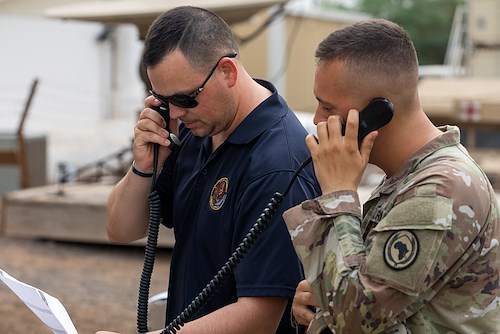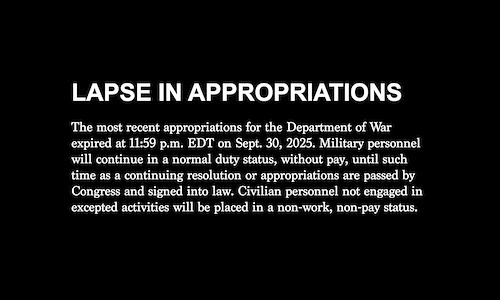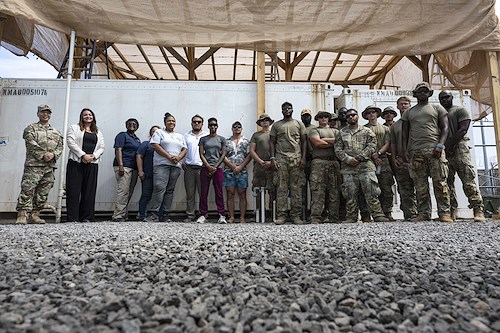Gallery contains 4 images
×
Photo 1 of 4
Communications directorate keeps HOA connected
U.S. Army Spc. Chase Davis, left, and U.S. Army Spc. Sean Carney, both Combined Joint Task Force-Horn of Africa radio maintenance specialists, check their signal strength during a communications exercise at Camp Lemonnier, Djibouti, Sept. 27, 2023. The Expeditionary Communications Directorate’s mission is to provide CJTF-HOA the best military advice on equipment and capability while advancing cyber defense, and joint and coalition interoperability, thus enabling the joint force to develop, maintain, and strengthen strategic access and influence in Djibouti, operations throughout East Africa, and regional security. (Department of Defense photo by U.S. Air Force Staff Sgt. Dylan Gentile)
Photo by: U.S. Air Force Staff Sgt. Dylan
Photo 2 of 4
Communications directorate keeps HOA connected
U.S. Army Spc. Phantajia Smith, Combined Joint Task Force-Horn of Africa radio maintenance specialist, configures a radio antenna during a communications exercise at Camp Lemonnier, Djibouti, Sept. 27, 2023. Communications specialists are functional experts in the realms of fixing and providing the technology for anyone leaving the confines of Camp Lemonnier. (Department of Defense photo by U.S. Air Force Staff Sgt. Dylan Gentile)
Photo by: CJTF-HOA Public Affairs
Photo 3 of 4
Communications directorate keeps HOA connected
U.S. Army Spc. Sean Carney, Combined Joint Task Force-Horn of Africa radio maintenance specialist, adjusts a satellite dish during a communications exercise at Camp Lemonnier, Djibouti, Sept. 23, 2023. Communications specialists support everyone from security forces, the East Africa Response Force, and training exercises to the more mundane daily activities of sending emails and browsing the web. (Department of Defense photo by Staff Sgt. Dylan Gentile)
Photo by: CJTF-HOA Public Affairs
Photo 4 of 4
Communications directorate keeps HOA connected
U.S. Army Spc. Phantajia Smith, Combined Joint Task Force-Horn of Africa radio maintenance specialist, adjusts a radio system during a communications exercise at Camp Lemonnier, Djibouti, Sept. 24, 2023. Communications troops host a monthly communications exercise, testing networks and communications across a range of means, to ensure no matter what happens, Combined Joint Task Force-Horn of Africa stays in constant contact with those conducting missions. (Department of Defense photo by U.S. Air Force Staff Sgt. Dylan Gentile)
Photo by: CJTF-HOA Public Affairs
A team of soldiers work between an array of dishes, wires, and antennas fine-tuning their radios and troubleshooting connections to make calls and send messages across miles of rocky desert.
The Expeditionary Communications Directorate’s overall mission is to provide the Combined Joint Task Force-Horn of Africa with the best advice on equipment and capability while advancing cyber defense, and joint and coalition interoperability. This enables the joint force to develop, maintain, and strengthen strategic access, influence, operations, and regional security throughout East Africa.
Troops within the directorate supply equipment and personnel with the knowledge and experience to fix and utilize communications technology. They also provide specialized training across devices to service members downrange.
To showcase and stress-test their mission, the tech-savvy soldiers host a monthly communications exercise. The goal of the communications exercise is to ensure that radios, cell phones, and other transmission equipment can work in the case of an emergency or operation. One way they do this is by running through Primary, Alternate, Contingency, and Emergency, plans referred to as PACE plans. For example, if the radio is your primary means of conveying information downrange, texting on a cell phone could be your alternate form of communication depending on the scenario.
These exercises ensure the Combined Joint Task Force-Horn of Africa stays in constant contact with those conducting missions. They could be on the ground, in the air, or on the water, but the communications specialists will find a way to reach them.
“The COMMEX is to see how fast we can be and how prepared we are for an event where we need to deploy our communication capabilities,” said U.S. Army Spc. Sean Carney, CJTF-HOA radio maintenance specialist. ”If there was civil unrest or a disturbance in the theater we want to be ready to be able to stay in touch and coordinate with each other and our friendly forces.”
One function of the directorate exercised in the COMMEX, is Tactical Gear (TACGEAR). They provide everything from commercial phones to satellite phones, or radios depending on the needs of the operation. They are the experts in fixing and providing the technology for anyone leaving the confines of Camp Lemonnier.
“You can’t do anything without being able to talk, right,” said 2nd Lt. Lauren Beed, small node support platoon leader. “We definitely take great pride in being the ones to send our equipment out with our operators and provide them with those capabilities.”
They support everyone from security forces and the East Africa Response Force to the more mundane daily activities of sending emails and browsing the web. Any service member who has enjoyed the luxury of watching a show or messaging a loved one outside of Camp Lemonnier while on the continent, has likely enjoyed the hard work of the communications directorate.
“Everybody is engaged and working their hardest to make sure [CJTF-HOA] members have reliable communications,” said Beed. “Everyone here has been working really well together and I’m really thankful to everyone from the team coming together to make the mission go smoothly.”
















